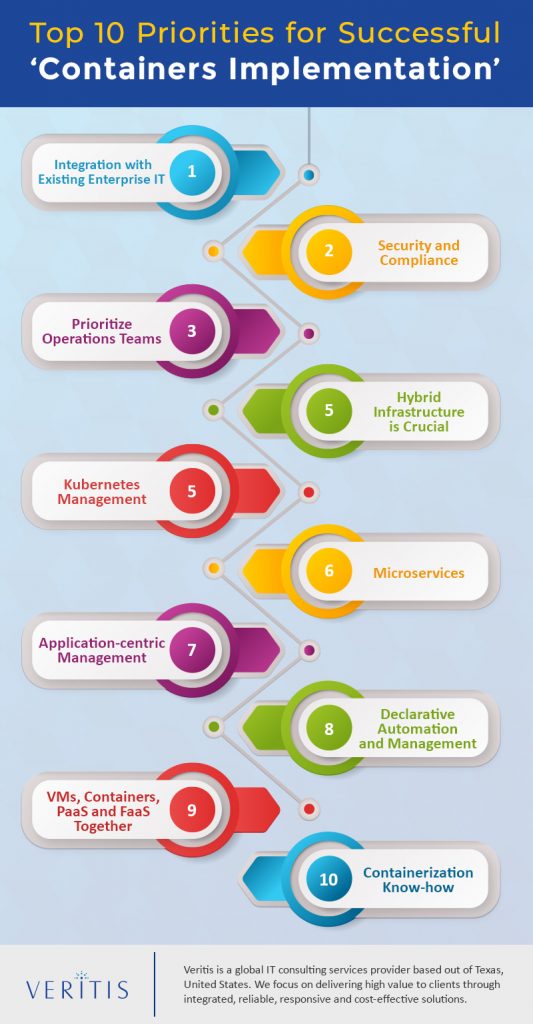Top 10 Priorities for Successful ‘Containers Implementation’

Digital transformation trend has changed the way IT business functions, pushing software delivery and lowered operational costs to the forefront.
To the question as to ‘what brought this change?’, the IT industry’s answer is ‘DevOps and Containers’!
One of the leading reports on IT professionals’ and enterprises’ top preferences places ‘container management’ on top of everything.
Majority enterprises look at ‘containers’ as a means to enhance software delivery, minimize operational expenditure, meet Service Level Agreements (SLAs), security and compliance.
Top 10 priorities underpinned by the surveys for Containers Implementation and DevOps in production and at scale:

1) Integration with Existing Enterprise IT
Integrating containers with the existing enterprise IT infrastructure remains a priority for most enterprises, with focus on infrastructure elements such as networks, hypervisor, storage, server automation, clouds and configuration management tools.
While 62% of the surveyed consider this as ‘very important’, 23% consider ‘critical’, followed by 14% ‘important’ and 1% ‘unimportant’.
2) Security and Compliance
Bringing in containers that match security and compliance factors in an organization is another priority, where the thought is all about differences in container lifecycle management over traditional Virtual Machines VMs).
Security & Compliance (36%), followed by Performance (22%), Complexity (21%), Personnel skillset (12%) and Availability (9%) remain to be the key container management pain points.
3) Prioritize Operations Teams
Current infrastructure, platform and application operators find it hard to manage container environments. Considering the pace of containers implementation and the demand for containerized applications, scalability, security and compliance play crucial to container operations. So, container management solutions cannot just be developer-oriented. IT operations teams have a special role.
4) Hybrid Infrastructure is Crucial
Containers can be hosted off and on-premises. The survey found 53% enterprises using containers on on-premise VMs, followed by 38% on off-premise container services, 36% on on-premise bare metal services, 32% on off-premise VMs and off-premise bare metal services.
Meanwhile, 26% enterprises are also looking at container management solutions to manage Function-as-a-Service (FaaS).
5) Kubernetes Management
Kubernetes is known for its effective container orchestration and scheduling framework. Because of this reason, its considered a standard for container deployment and management in production and at scale. By providing standard APIs, Kubernetes simplifies code deployment for developers in line with the organizational IT policies within less timeframe.
6) Microservices
These are basically functional components with standardized APIs that can be combined into modern-day apps or integrated to traditional enterprise applications.63% of today’s microservices-based apps run on containers, followed by 30% planning to do so within a time frame of 12 months and 8% with no such plans. So, transition to microservices is definitely a big push for container adoption.
7) Application-centric Management
Application-centric container management makes many things, part of application delivery chain, easier without the dependence on underlying IT infrastructure. These include policy-driven deployment, monitoring and scaling, updates and upgrades of all containerized applications.
Thus, the application-centric Container-as-a-Service (CaaS) management model forms an abstraction layer above container services, making it easier for customers to choose between application deployment in the data center or cloud platform.
8) Declarative Automation and Management
Another top priority is achieving transition to declarative management, which completely relies on Dev and Ops teams who decide the state of an application. Security and compliance checks also form key to this process of application management lifecycle. Declarative automation and container management helps achieve scalability and portability at the cross-platform level, rapidly.
9) VMs, Containers, PaaS and FaaS Together
It has to be noted that the classic combination of all these yields better results. In the survey, majority developers opted for containers (alongside PaaS) to achieve flexibility. While some said containers, along with PaaS, help in easy onboarding of legacy apps.
The percentage of others who said ‘IT operations preferred containers over PaaS’ is less and far less is the percentage of enterprises who said ‘PaaS is either hard or not accepted by developers’. This clearly shows how significant can be the combination of containers and other functionalities like PaaS, FaaS, etc.
10) Containerization Know-how
Containerization can be a compelling factor owing to its advantages to driving app delivery cycles. But its important to study the business use cases, host and hardware dependencies, configurations and variables, among others that can reduce operational complexity in application containerization.
Now that you have the Top 10 priorities for adopting containers, it’s time to gear up to plan for a full-fledged container implementation strategy.
Related News